Kneeling at the crossroads of faith and destiny, biblical pilgrims' journeys reveal timeless lessons on courage, trust, and divine pursuit.
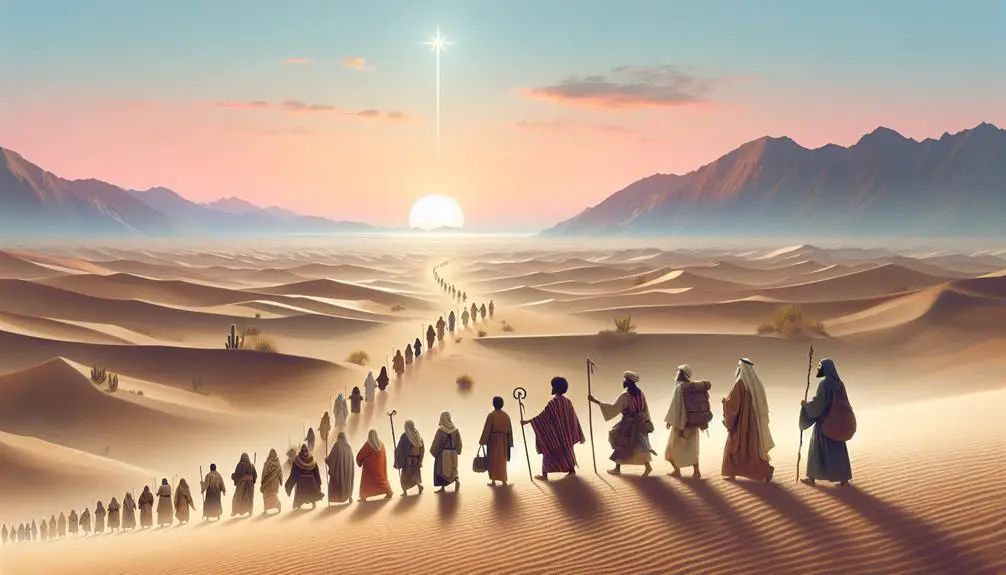
Pilgrims in the Bible
When you think of Abraham leaving Ur, you're reminded of the quintessential pilgrim's journey, fueled by faith and a promise of a new homeland. This leap of faith marks just the beginning of a series of profound pilgrimages woven throughout the Bible, from Moses leading the Exodus to the emotional return from Babylon.
Each story carries its own lessons on faith, perseverance, and divine guidance. As you explore these narratives, you'll discover how these ancient pilgrimages echo in today's quests for spiritual meaning. The question is, how do these stories resonate with you, and what can they teach us about navigating our own life's journeys?
Key Takeaways
- Biblical pilgrimages often symbolize transitions from physical bondage to spiritual liberation and covenants.
- Pilgrimages entail embracing uncertainties and demonstrating active faith through obedience and trust.
- Economic factors, cultural assimilation, and divine intervention significantly influence the journeys and decisions of biblical figures.
- Personal and spiritual growth are recurrent themes, highlighting the transformative power of adversity and faith in the pilgrims' narratives.
Abraham's Leap of Faith

Abraham's leap of faith, a pivotal moment in biblical history, showcases his unwavering trust in God's promise despite facing the unknown. This act isn't only remarkable for its courage but also illuminates the essence of faith itself. You're invited to delve into the depths of this narrative, exploring both the significance of Ur and the foundational nature of faith that Abraham exemplifies.
Ur's significance in this context can't be overstated. As Abraham's homeland, Ur was a cradle of civilization, a place of prosperity and advanced culture. Yet, Abraham's readiness to leave Ur, prompted by God's call, underscores a profound detachment from material security and familiar comforts. This departure from Ur is emblematic of a spiritual journey, one that you might recognize as a call to prioritize spiritual values over worldly ones.
Faith's essence, as demonstrated by Abraham, is rooted in trust and obedience. It's the ability to move forward even when the path isn't clear, to believe in the promise of something greater beyond the present reality. You're seeing here a model of faith that's active, not passive. It's a faith that engages with the uncertainties of life, not by seeking guarantees, but by embracing the unknown with confidence in divine guidance.
In analyzing Abraham's leap of faith, it's essential to appreciate how it sets a precedent for understanding faith's role in navigating life's challenges. You're observing a foundational moment that encourages a deeper reflection on the nature of your own faith and its capacity to guide you through the unknown, much like Abraham was guided from Ur to a new destiny.
Moses and the Exodus
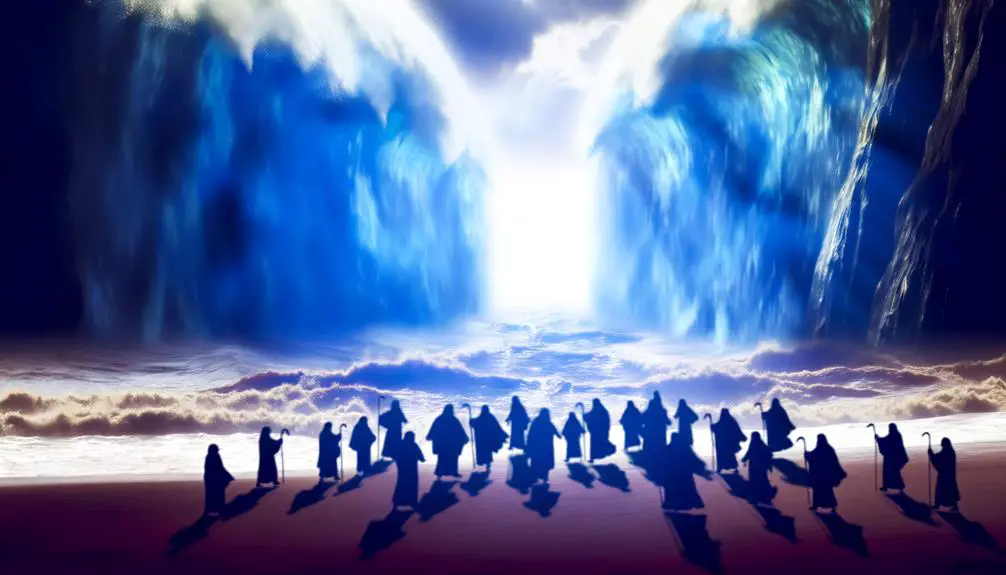
In the wake of Abraham's journey, Moses's leadership during the Exodus marks another monumental chapter in the narrative of faith, as it demonstrates the collective liberation of the Israelites from Egyptian bondage. This pivotal event isn't just a tale of freedom; it's a profound exploration of faith under duress, showcasing how divine intervention through plague miracles paved the way for liberation.
The Exodus story is meticulously detailed, highlighting the ten plagues as acts of divine judgment against the Egyptian gods, directly challenging Pharaoh's refusal to release the Israelites. These plagues culminate in the Passover, a pivotal moment that not only signifies the Israelites' liberation but also establishes a lasting ritual, embedding the memory of deliverance into the fabric of their collective identity.
Following their escape, the Israelites' journey to Mount Sinai represents a transitional phase from physical liberation to spiritual covenant. Here, Moses's role transcends that of a liberator; he becomes the mediator of the Sinai covenant, a cornerstone in the Israelite faith. This covenant isn't merely a set of laws; it's a binding agreement between God and the Israelites, setting the foundations for their relationship and obligations to each other.
Analyzing the Exodus through the lens of pilgrimage, it's evident that this journey was as much about physical movement as it was about spiritual transformation. The ordeal in the desert, the reception of the Ten Commandments, and the establishment of the Sinai covenant, all underscore a collective rite of passage—a transition from bondage to a covenantal relationship with God, which fundamentally shaped the Israelite identity and faith.
Joshua's Conquest of Canaan
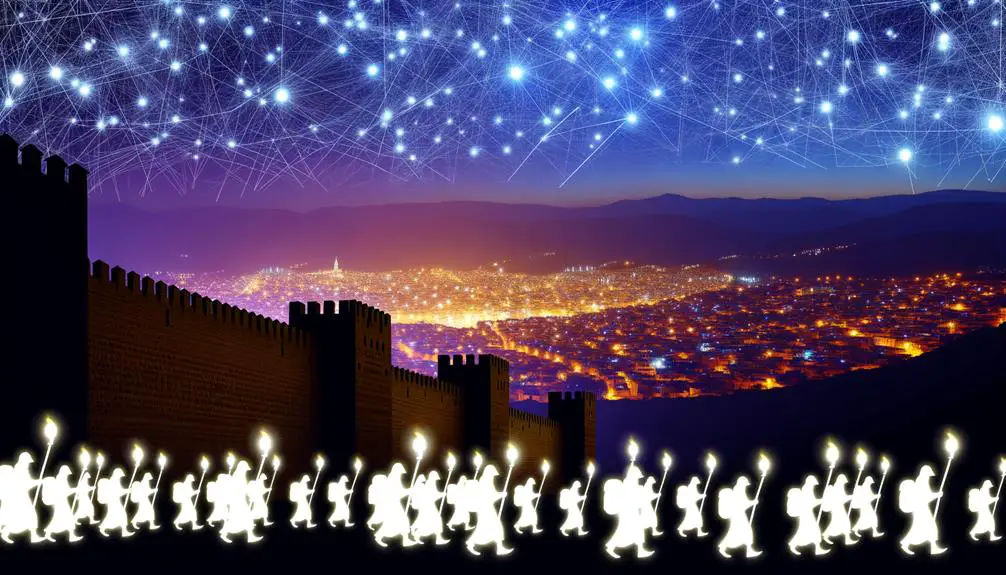
Following Moses' leadership, you now encounter Joshua's pivotal role in the biblical narrative through his conquest of Canaan.
The Battle of Jericho stands out as a strategic military maneuver that significantly weakened Canaanite cities, altering the region's socio-political landscape.
This event's impact on Canaanite cities underscores the broader implications of Joshua's military campaigns for the land's future inhabitants.
Battle of Jericho Strategy
Joshua's strategic approach to the Battle of Jericho, a key moment in the conquest of Canaan, showcases a blend of divine instruction and military tactics. This operation, pivotal in the biblical narrative, leveraged unique siege tactics, underpinned by archaeological evidence, to achieve victory.
Aspect |
Description |
Impact |
|---|---|---|
Divine Command |
March around the city for seven days |
Psychological warfare |
Siege Tactics |
No direct assault until the final day |
Minimized casualties |
Archaeological |
Evidence of collapsed walls |
Validates biblical account |
Military Outcome |
Quick conquest following the wall collapse |
Swift victory |
This strategy, balancing patience with decisive action, underlines the importance of faith and strategy in achieving objectives.
Impact on Canaanite Cities
The conquest of Jericho set a precedent for how Joshua and his forces approached the subsequent invasions of Canaanite cities, significantly altering the region's socio-political landscape. This shift wasn't just a matter of new rulership; it deeply impacted Canaanite culture and had profound economic implications.
As you delve deeper, you'll notice that the systematic dismantling of Canaanite city-states disrupted established trade routes, leading to economic instability. The absorption or destruction of these cities under Joshua's campaign meant that the rich tapestry of Canaanite culture, known for its religious and trade practices, faced significant suppression.
This, in turn, reshaped the identity and economic foundations of the region, paving the way for a new socio-political order that echoed through history.
The Pilgrimage of Ruth
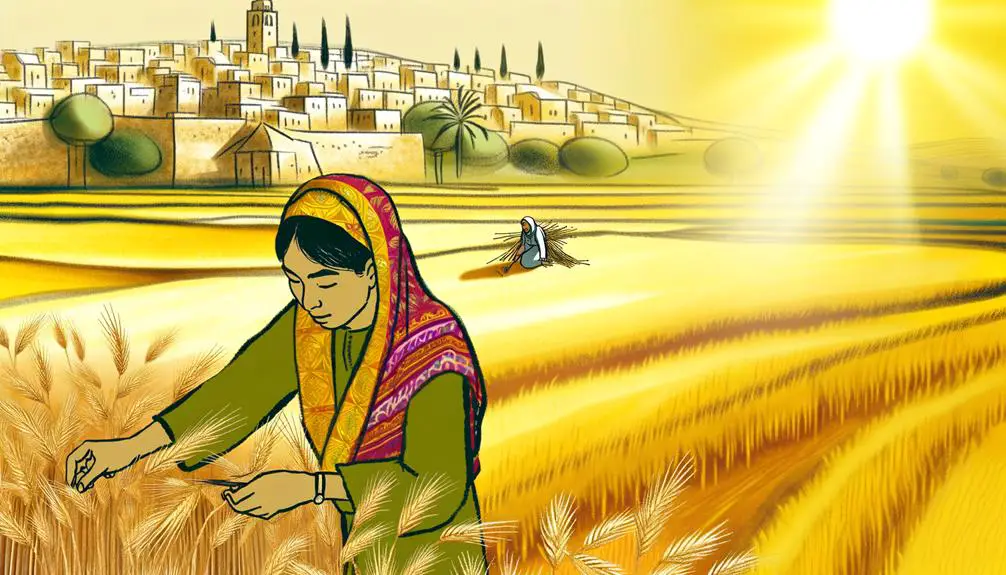
You'll find Ruth's journey from Moab to Bethlehem not just a physical relocation but a profound transition in her life and faith.
Her loyalty, especially her famous declaration of sticking with Naomi, her mother-in-law, underscores a pivotal shift towards the God of Israel and a new community.
This pilgrimage, therefore, isn't merely about the miles traversed but encapsulates a significant spiritual and emotional transformation within Ruth.
Ruth's Loyal Journey
Ruth's unwavering commitment to her mother-in-law, Naomi, exemplifies a pilgrimage fueled by loyalty rather than geography, underscoring the profound personal and spiritual journey she undertakes. Her story is a testament to the power of Ruth's devotion and the challenges of cultural integration in a foreign land. This journey isn't just a physical relocation but a deep, transformative process.
- Ruth's Devotion: A steadfast loyalty that challenges societal norms and expectations.
- Cultural Integration: Navigating and adapting to new customs and traditions while retaining one's identity.
- Spiritual Journey: Embarking on a path that strengthens faith and personal belief systems through trials and tribulations.
Ruth's tale is a rich narrative that explores themes of loyalty, adaptation, and the search for a place in a new community, all while maintaining a strong spiritual and personal identity.
Moab to Bethlehem Transition
Building on her unwavering commitment, the pilgrimage from Moab to Bethlehem showcases Ruth's profound personal and spiritual evolution amidst a backdrop of significant cultural and geographic change. This journey isn't just a physical relocation but a testament to her adaptability and determination to integrate culturally while driven by economic motivations.
Aspect |
Impact |
|---|---|
Cultural Integration |
Ruth's assimilation into Bethlehem's social fabric illustrates the challenges and rewards of adopting new cultural norms. |
Economic Motivations |
Her move is partly driven by the pursuit of better economic prospects, highlighting the timeless link between migration and livelihood. |
Personal Evolution |
Ruth's journey symbolizes a transformation from a foreign widow to a respected community member. |
Spiritual Growth |
Embracing a new faith and God, her pilgrimage reflects profound spiritual enlightenment and commitment. |
Ruth's story is a powerful narrative of resilience, faith, and the universal quest for belonging and stability.
David's Flee and Faith

David's flight from Saul marks a pivotal moment in his spiritual journey, emphasizing his deep reliance on faith during times of peril. Before this flight, David's life was intertwined with King Saul's, initially marked by victory and favor. The turning point came after David's defeat of Goliath, a challenge that catapulted him into the national spotlight. Saul's jealousy over David's rising popularity and God's favor towards him set the stage for David's flee. This period in David's life isn't just a tale of escape but a profound lesson on faith under duress.
- Saul's jealousy: It was a catalyst for David's journey, pushing him from the royal courts into the wilderness.
- Goliath challenge: This victory brought David fame but also sowed the seeds of Saul's envy.
- Faith in peril: Throughout his flee, David's reliance on God showcases a faith that endures in the face of adversity.
David's experiences during his flight from Saul reveal the complexities of his faith journey. He navigated the wilderness, not just geographically but spiritually, relying on God's guidance and protection. This period was characterized by moments of profound trust, but also instances of fear and uncertainty. David's interactions with the priests at Nob, his strategic alliances, and his psalms from this period reflect a man seeking God's will amidst life-threatening challenges.
Analyzing David's flee and faith, it's evident that his spiritual odyssey was shaped by adversity. His reliance on God during this tumultuous time underscores the essence of faith—not just believing in times of peace but trusting amid storms.
The Return From Babylon
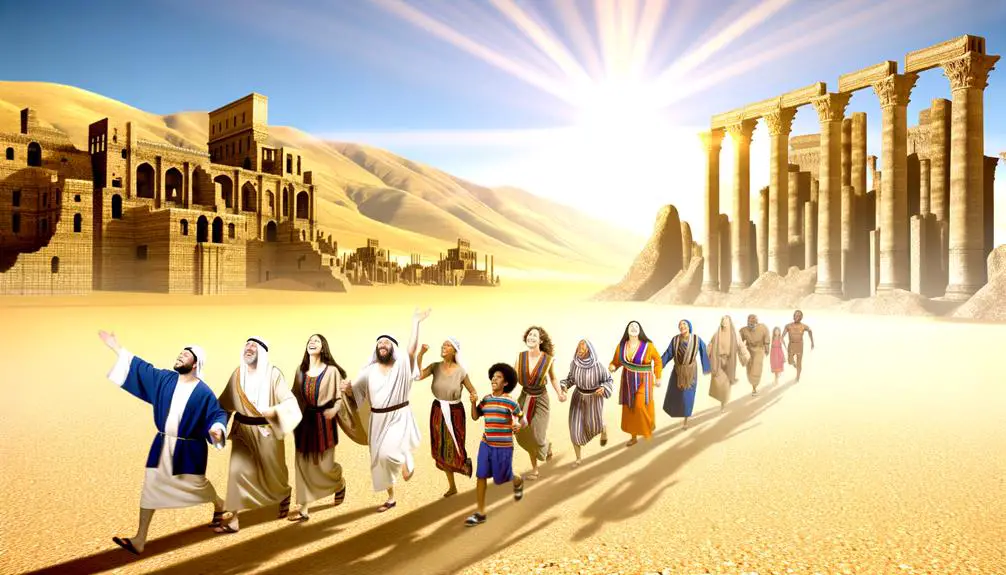
The return from Babylon represents a critical juncture in the collective spiritual journey of the Israelites, marking both an end and a new beginning after years of exile. Initiated by Cyrus's decree, this event wasn't just a political maneuver but a fulfillment of prophetic declarations, showcasing the intertwining of divine providence with human governance. Cyrus, the Persian king, not only facilitated the return of the Israelites to their homeland but also sanctioned the rebuilding of the Temple in Jerusalem. This act wasn't merely about reconstructing a physical structure but was symbolic of the restoration of the Israelite community's faith and identity.
The Temple rebuilding, following the return, was fraught with challenges, including opposition from neighboring communities and the daunting task of reconstructing what had been lost or destroyed. Yet, it stood as a powerful symbol of resilience and faith. This phase in their pilgrimage underlines a profound lesson on the importance of communal effort, leadership, and faith in the face of adversity. The process of rebuilding the Temple served as a catalyst for the reinvigoration of religious practices and the re-establishment of the covenantal relationship between the Israelites and their God.
Analyzing this period from a detailed and objective perspective, it's evident that the return from Babylon and the subsequent Temple rebuilding were pivotal in reshaping the identity and spirituality of the Israelite community. It wasn't just a return to a geographical location but a profound journey back to faith, community, and covenant living.
Frequently Asked Questions
How Did the Concept of Pilgrimage Evolve in the Context of Other Ancient Religions Outside of the Bible?
In ancient religions outside the Bible, pilgrimage evolved uniquely. The Hindu Kumbh Mela, for instance, became a mass gathering for purification, drawing millions to sacred rivers.
Similarly, the Islamic Hajj emerged as a mandatory pilgrimage to Mecca, embodying spiritual renewal and unity for Muslims worldwide.
Both traditions reflect the universal quest for spiritual depth, transcending cultural differences while emphasizing communal participation and personal transformation.
What Are the Modern-Day Practices or Traditions That Can Be Traced Back to the Biblical Concept of Pilgrimage?
Today, you'll find that modern religious retreats and spiritual journeys echo ancient practices. These traveling faiths, through cultural adaptation, have preserved the essence of seeking divine closeness outside one's immediate environment.
Analyzing these traditions, it's evident how deeply they're rooted in historical pilgrimage concepts. From visiting sacred sites to participating in communal rituals, these activities demonstrate the continuity and evolution of religious practices, bridging ancient beliefs with contemporary spiritual quests.
Are There Specific Locations Mentioned in the Bible as Pilgrimage Sites That Are Still Recognized and Visited Today?
Yes, there are specific locations with historical accuracy and geographical significance mentioned that you'd recognize and still visit today. Jerusalem, with its ancient temples, and Bethlehem, the birthplace of Jesus, stand out.
These sites aren't just tourist attractions but carry deep religious significance for many. Their enduring appeal underscores their role in faith and history, making them key destinations for those seeking to connect with their spiritual heritage.
How Did the Role and Perception of Pilgrims Change Throughout the New Testament Compared to the Old Testament?
You're exploring how perceptions of pilgrims evolved, focusing on their transformative journeys.
Initially, Temple journeys in the Old Testament highlighted physical treks to sacred spaces, embodying covenantal faithfulness.
Contrastingly, the New Testament shifts towards Covenant journeys, emphasizing spiritual pilgrimages towards personal faith and community.
This evolution mirrors a broader narrative from physical to spiritual, reflecting a deepening understanding of pilgrimage not just as a location, but as a journey of the soul.
What Psychological or Spiritual Effects Did Pilgrimages Have on Individuals and Communities in Biblical Times, and How Is This Understood Today?
You're exploring how pilgrimages impacted individuals and communities psychologically and spiritually. This journey often led to profound personal transformation and a deeper sense of belonging within communities.
Analyzing pilgrim psychology, it's clear these experiences fostered resilience, hope, and a stronger faith. Community transformation was equally significant, as shared pilgrimages strengthened bonds and collective identity.
Today, this understanding helps appreciate the lasting influence of such spiritual journeys on personal and communal levels.
Conclusion
In your journey through the narratives of biblical pilgrimages, you've ventured alongside Abraham's bold faith, Moses's liberating exodus, Joshua's triumphant conquest, Ruth's devoted migration, David's strategic retreat, and the exiles' hopeful return.
These stories, rich in detail and analysis, reveal a profound truth: faith propels the faithful forward, through uncertainty and trial. As you reflect on their journeys, consider the paths you're on. Will you, like them, move with courage towards the unknown, trusting in a promise unseen yet deeply felt?



Sign up